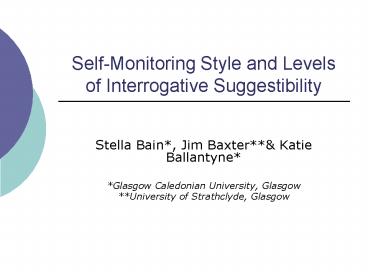SelfMonitoring Style and Levels of Interrogative Suggestibility PowerPoint PPT Presentation
1 / 15
Title: SelfMonitoring Style and Levels of Interrogative Suggestibility
1
Self-Monitoring Style and Levels of Interrogative
Suggestibility
- Stella Bain, Jim Baxter Katie Ballantyne
- Glasgow Caledonian University, Glasgow
- University of Strathclyde, Glasgow
2
Interrogative Pressure
- Cognitive and social factors present during
interviews which may compromise recall accuracy - (cf. Gudjonsson, 2003)
- Interrogative Suggestibility
- (Gudjonsson, 1983 2003)
- the extent to which, with in a closed social
interaction, people come to accept messages
communicated during formal questioning as a
result of which their subsequent behavioural
response is affected - (Gudjonsson Clark, 1986, p. 84)
3
Interrogative Suggestibility
- Gudjonsson Clark (1986)
- Interrogative suggestibility dependent on coping
strategies - Interviewee cognitive set is influenced by
uncertainty, expectation and trust in interviewer - Cognitive set may facilitate either a resistant
or a suggestible behavioural response - Negative feedback is also an important
determinant of suggestible responding
4
Interrogative Suggestibility
- Negative feedback can increase uncertainty and
anxiety - (Gudjonsson Clark, 1986 Gudjonsson, 2003)
- Increased anxiety is likely to lead to
interviewees attending to external cues - (Gudjonsson, 2003 Bain et al., 2004)
- Increases in interrogative pressure associated
with negative feedback can divert attention away
from task of discrepancy detection - (cf. Schooler Loftus, 1986 Bain et al., 2004)
5
Background to Study
- Negative feedback and repetition of questions
increase levels of interrogative pressure - (Gudjonsson, 2003)
- Abrupt interviewer demeanour increases levels of
interrogative suggestibility - (Bain Baxter, 2000 Baxter Boon, 2000 Bain
et al., 2004)
6
Background to Study
- Stern interviewer demeanour increases
psychological distance - (Baxter Boon, 2000 cf. Gudjonsson Lister,
1984) - Stern/abrupt interviewers gain higher GSS scores
from interviewees - (Bain Baxter, 2000, Baxter Boon, 2000 Bain
et al., 2004)
7
Background to Study
- Interviewees under increased interrogative
pressure are likely to attend to situational
dynamics - (Bain Baxter, 2000)
- Increases in interrogative pressure divert
attention from detecting discrepancies between
GSS narrative and questions - (Bain et al., 2004 cf. Schooler Loftus, 1986)
8
Background to Study
- Lower levels of self-esteem also associated with
increased susceptibility to interrogative
pressure - (Baxter et al., 2003 Bain et al., 2004)
- Low self-esteem interviewees may attend more to
situational demands than high self-esteem
individuals - (Baxter et al., 2003 Bain et al., 2004 cf.
Gudjonsson, 2003)
9
Background to Study
- The tendency to attend to situational cues to
socially appropriate behaviour has been termed
self-monitoring - (Snyder, 1974)
- High self-monitors tend to be more attentive to
situational demands than low self-monitors - (Snyder, 1987 Perrine Aloise-Young, 2004)
10
Current Study
- Aim
- to examine the relationship between attention to
social cues, as measured by the self-monitoring
scale (Snyder, 1974), and scores obtained on the
GSS - Hypothesis
- High self-monitors would gain higher GSS scores
than low self-monitors
11
Current Study
- Method
- one independent variable
- self-monitoring
- two conditions
- high and low self-monitors
- forty undergraduate participants
- 20 per condition
- mean age 22.33 (S.D. 4.05, range 18-43)
12
Current Study
- Procedure
- 200 students completed Snyders self-monitoring
scale - 20 high scorers (gt15) and 20 low scores (lt9)
recruited - All participants tested on GSS1 in accordance to
guidelines provided by Gudjonsson (1997)
13
Current Study
14
Current Study
- Conclusions
- High self-monitors scored higher on Yield, Shift
and Total Suggestibility than did low
self-monitors - High self-monitors are more susceptible to both
the pressures of leading questions and the
pressures of negative feedback associated with
the normal administration of the GSS - Individuals who have a tendency to self-monitor
their behaviour may be more likely to experience
increased uncertainty as a result of attending to
their feelings and their perceptions of the
interview at the expense of recall effort
15
Current Study
- Conclusions
- By concentrating attention on the social dynamics
of the situation high self-monitors will be less
likely to notice mismatches between what they can
recall and misinformation than low self-monitors - The results support those of previous studies
investigating the effects of variations in
interviewee self-esteem - Interviewees who attend to internal states show
elevated GSS scores - (e.g. Baxter, Jackson Bain, 2003 Bain, Baxter
Fellowes, 2004)

